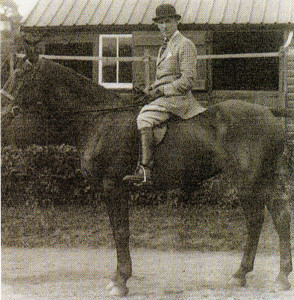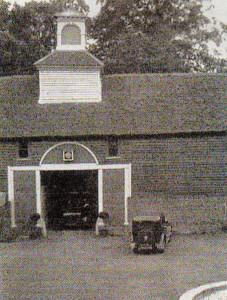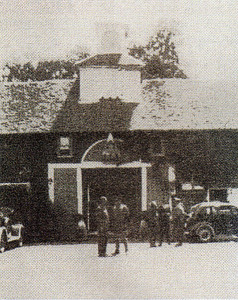
My father had foreseen the catastrophe war would bring to his way of life. The bulk of his work as a veterinary surgeon in the late 1930s had involved horses – in racing, hunting and polo – and, to a lesser extent, dogs and cats. He knew this work would diminish or even disappear soon after war broke out, so he and mother decided it would be sensible to sell the practice and go farming. He also knew from the first war in which, aged 18, he was wounded and gassed, that the nation would need home-produced food, and that farming would have to climb out of its recession.
However, when he’d found a purchaser for his practice at Wonersh, near Guildford, Surrey, and the deal was waiting to be signed, war was declared so the purchaser didn’t sign. Father had left it just too late!
As he’d feared, the practice swiftly ground to a halt. The 22 stables and kennels for 80 emptied, except for his own animals. Ironically, his work now consisted largely of destroying his livelihood by meeting endless requests to destroy unwanted animals – unwanted because food and labour were in short supply.
Another use was soon found for the empty stables that took him by surprise. It also surprised those who thought the army was now so mechanised that horses were outdated instruments of war. But army remount officers visited the stables and requisitioned those they wanted. They left only the ponies, an unsound hunter of father’s, and mother’s thoroughbred gelding that was too light to carry a soldier. The compensation paid for those taken bore little relation to their real worth.
Next, the army decided to requisition his paddocks and yard as a collecting centre for other horses requisitioned from the South-East. During the following weeks all available hands were kept busy tending to and exercising the dozens of horses that arrived in ones and twos each day by road and rail. The boxes were divided with swing bales to pack them in, and every space in barns and other outbuildings was soon taken.
When we could accommodate no more, by which time we had enough to make up a trainload, we led them to Bramley railway station – three to each man and woman and two for me, and entrained them eight at a time into cattle trucks for some secret destination.

The following year an anti-aircraft gun emplacement was established in the paddock. The gun crews were given sleeping quarters in the hay lofts above the stables. Our peaceful home had been further invaded, and suffered damage from troops, equipment and three-ton lorries.
By now, father felt that the jobs filling his time could easily be done by an older man, and that he would better be employed by his old regiment, so he travelled to their headquarters in London in the hope of being able to help the war effort more actively.
To his great disappointment, they classed him unfit for service (at 42 years old) due to the damage he’d received during the First World War.
Then the authorities became concerned about the increasing number of air-raids, and advised householders to construct shrapnel-proof shelters for their families. Two large beech trees were felled in one of our paddocks, split down with wedges, and the lengths used to support a roof of sandbags over the deep pit dug nearby. A completed dug-out reminded father of those he’d got to know so well on the Western Front in the Great War (the war that was to end all wars!). It was comfortable and had two bunks for my four-year-old sister Ann and myself, aged 14.
When the air-raid siren wailed its warning in the village, Ann was carried from her bed wrapped in blankets and half asleep, with me walking dozily beside her, to be transferred to the bunks by candlelight. Despite the time and effort that had gone into it, the dug-out was so damp and airless that our parents decided it was bad for health and morale, and it was abandoned after the first three raids. We never returned to it even after some stray bombs fell near enough to the village to break roof-tiles and windows with their blast.
We did all go into the paddock one night to view the first bombing of the London Docks – an impressive spectacle in spite of its distance from us. We watched the seemingly endless procession of enemy aircraft
cross the moon, emitting the peculiar two-toned drone of their engines, which we came to know so well as menacing noise. That night, to our dismay, there appeared to be no opposition to the aerial invaders from our aircraft or anti-aircraft guns. The horizon over the docks was lit blood-red from fires caused by the bombing .
On May 14 1940, Anthony Eden, the Secretary of State for War, broadcast that a ‘citizens’ army’, called the Local Defence Volunteers (LDV), was to be formed, and asked men aged between 17 and 65 who wanted to join to report to their local police station.
Companies and battalions were formed who armed themselves with anything remotely appropriate: shotguns, target rifles, old swords and revolvers, pitchforks, lances and ancient hammer-guns.

Father obtained the authority to raise and Command a mounted unit to patrol and guard a section of the North Downs against enemy parachutists. He was helped by the enthusiasm of those local riding folk who, like himself, were too infirm to serve overseas but were keen to contribute to the war effort in some way.
He soon raised The Mounted Section, 1st Surrey Battalion, LDV, a squadron of 60 men and horses, and the first mounted unit in the country. One youth, myself aged 15, joined them during school holidays. At first we had no uniforms, just a white arm-band carrying the letters ‘LDV’, and our arms consisted mostiy of twelve-bore scatter guns loaded with AAA shot (sizeable pellets) and a full charge. To our great relief, these never had to be fired. The ancient percussion-hammer guns would very likely have burst their barrels with such a charge.
Two months after Eden’s broadcast Churchill changed the name to The Home Guard. It became better equipped as time went on, starting with khaki uniforms and Enfield rifles.
We had training parades twice weekly in the paddocks for rudimentary discipline and drill, both mounted and dismounted. Father was soon able to divide the squadron into four troops, each with its own officer responsible for a section of a wide stretch of downs, from Blackheath to Holmwood, that had to be covered.
Our special duty was to watch for enemy parachute landing, so we mounted regular dawn patrols with ‘boot and saddle’ in the preceding darkness, as well as moonlight patrols on the clear nights when enemy parachute landings could be expected.
The cavalcade would clip-clop noisily through the sleeping villages to and from the patrol grounds in the hills, embracing miles of heather and gorse, scrub and woodland. When patrolling duties were finished at dawn, the volunteers would hack back to their homes through the peace and beauty of a dawning countryside.
However bizarre and ‘Dad’s Army’ it might seem in retrospect, the threat of the imminent invasion of our unprepared country was real, and treated seriously in spite of the ribbing the force got from local villagers.
Michael Berwyn-Jones








